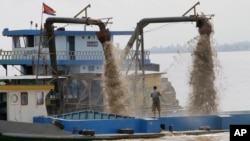The Thai government is backing a plan by China to demolish islets and rocky outcrops on the Mekong River as part of a decade long project to boost shipping navigation from China's Yunnan province to Luang Prabang in Laos.
The project, known as the Development Plan for International Navigation on the Lancang-Mekong River (2015-2025) is set in three phases, with an initial survey, design, and environmental and social assessments.
The navigational “improvements” cover 630 kilometers from China to Myanmar boundary marker 243 to Luang Prabang. The aim is to make the river passable for 500-ton cargo vessels.
A second phase, starting in 2020, includes navigational improvements over a distance of 259 kilometers, as well as the construction of cargo and passenger ports.
In 2015 an estimated 3,500 commercial ships, largely between 100 and 300 tons, were making the journey bringing goods to Thailand.
Assistant Minister to the Thai Prime Minister’s Office Kobsak Pootrakool told Thai media that China, Laos, Myanmar and Thailand set up a team to survey the river and had agreed the navigation needed to be improved.
“For the safety of goods and transport of people, as well as reducing risk from accidents and environmental impacts, it is necessary to make way for navigational improvements in the river to make it passable for 500-ton ships,” Kobsak said.
Chinese Premier Li Keqiang set out the plan to improve inter-connectivity and cooperation among the six member countries of the Lancang-Mekong Cooperation (LMC) initiative: China, Cambodia, Laos, Myanmar, Thailand and Vietnam.
China is reported to be providing $1.54 billion in loans and $10 billion in credit lines to fund infrastructure and improve transport networks in the Mekong region.
Protests over environmental impact
But the plans, agreed to by the Thai Cabinet in late December, have triggered protests from conservationists who say clearing of the islets would have a “disastrous impact” on vital aquatic wildlife and local communities.
Conservationists say the latest plans come as the Mekong River is already facing impacts from dam construction, including three hydro-power projects now being built or under consideration by Laos on the lower Mekong mainstream.
Along the Lower Mekong, millions of people are dependent on the river as a vital source of food.
Conservationists' main concerns center on a 1.6 kilometer stretch of river, known as Khon PiLuang -- a stretch of islets and rocky outcrops, and a marker of the border between Thailand and Laos in Chiang Khnon district of Chiang Rai.
Phillip Hirsch, a professor of human geography at Australia’s Sydney University, said clearing of islets is the last major obstacle for large vessels to ply the river.
“The key site to which NGOs [non-government organizations] are focused and which local fishermen are concerned about is the set of rapids on the stretch of river between Chiang Saen – and Chiang Khong, called Khon Pi Luang. If they clear that area there there’s very little left by way of obstacles for the largest ships to go all the way downstream,” Hirsch told VOA.
Previous attempts to improve shipping
China’s plans to boost navigation on the Mekong River dates back over 25 years. Blasting of islets further upstream has already taken place. A program of blasting islets on the lower Mekong occurred in 2001, near Shan State in Myanmar.
In 2002 a Thai government under former prime minister Thaksin Shinawatra - aiming to win favor from China - proceeded with blasting upstream from Khon Pi Luang.
But the program was halted by the Thai Defense Ministry over fears of border disputes with neighboring Laos. The Thai-Lao border is set at the river’s deepest point. Destroying the islets would change the line of the border at a possible disadvantage to Thailand.
Conservationists say the islets have a vital role in fish habitat and breeding for the 200 species of fish living along that stretch of river.
Robert Mather, a scientist and conservationist, said destroying almost 270 different islets or outcrops is “potentially devastating” for the river’s aquatic diversity.
“These are areas, very important for fish breeding, fish eating areas, because you have algae growing on the rocks and islets. They are important,” Mather told VOA.
“The end result of what is happening is it’s making the river more like a canal really – it’s making it easier, it’s making it more uniform, so the diversity of different habitats will be reduced,” he said.
A coalition of local environmentalists representing eight Mekong Provinces has launched a campaign opposing the plans.
Pianporn Deetes, Thai campaign director for the U.S.-based International Rivers, said the wider impact of the plans is on local communities.
“We are now seeing the Mekong to be like a buffet for different companies, different government agencies to take to build their projects and to make their profits without considering the richness, the complex diversity and the eco-system,” Deetes told VOA.
Conservationists say China should further develop highway links from China to Laos as an alternative to sending cargo by river.
But economist Somphob Manarangsan said China sees the river system as the most efficient transport option. “All the other means of transportation or the going by car or other ways is difficult. [That’s] the reason why hundreds of ship that that travel the Mekong River from Yunnan province to Laos or Thailand,” Somphob told VOA.
Saowaruj Rattanakhamfu, a senior researcher with the Thailand Development Research Institute (TDRI), said based on foreign trade, China would gain the most from the increased trading business.
“From an economic perspective [Thailand] will not benefit from the water navigation plan,” Saowaruj told local media. She said the Lao people would even be at a greater disadvantage than the Thais. “The government should study whether it is really worth the investment as the project will have immense impacts on the poor,” she said.










